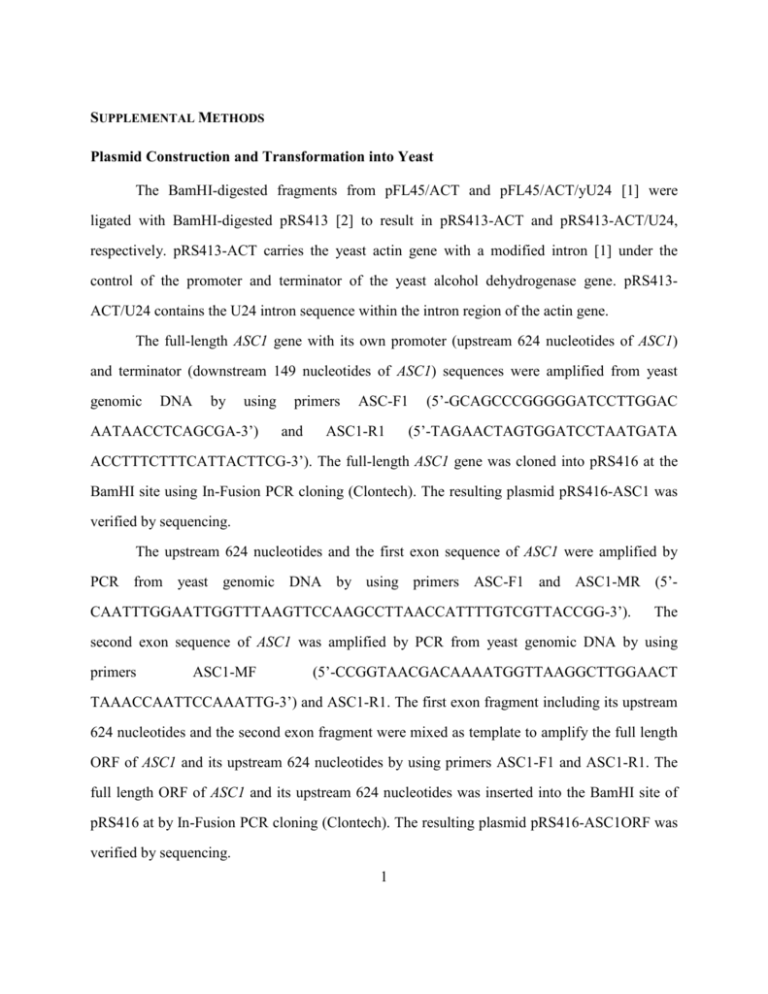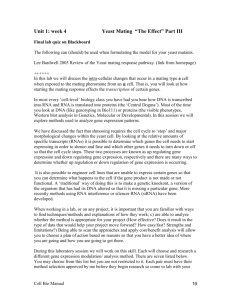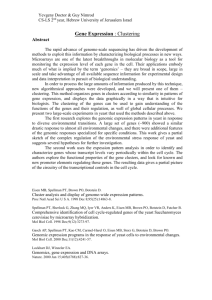
SUPPLEMENTAL METHODS
Plasmid Construction and Transformation into Yeast
The BamHI-digested fragments from pFL45/ACT and pFL45/ACT/yU24 [1] were
ligated with BamHI-digested pRS413 [2] to result in pRS413-ACT and pRS413-ACT/U24,
respectively. pRS413-ACT carries the yeast actin gene with a modified intron [1] under the
control of the promoter and terminator of the yeast alcohol dehydrogenase gene. pRS413ACT/U24 contains the U24 intron sequence within the intron region of the actin gene.
The full-length ASC1 gene with its own promoter (upstream 624 nucleotides of ASC1)
and terminator (downstream 149 nucleotides of ASC1) sequences were amplified from yeast
genomic
DNA
by
using
AATAACCTCAGCGA-3’)
primers
and
ASC-F1
ASC1-R1
(5’-GCAGCCCGGGGGATCCTTGGAC
(5’-TAGAACTAGTGGATCCTAATGATA
ACCTTTCTTTCATTACTTCG-3’). The full-length ASC1 gene was cloned into pRS416 at the
BamHI site using In-Fusion PCR cloning (Clontech). The resulting plasmid pRS416-ASC1 was
verified by sequencing.
The upstream 624 nucleotides and the first exon sequence of ASC1 were amplified by
PCR from yeast genomic DNA by using primers ASC-F1 and ASC1-MR (5’CAATTTGGAATTGGTTTAAGTTCCAAGCCTTAACCATTTTGTCGTTACCGG-3’).
The
second exon sequence of ASC1 was amplified by PCR from yeast genomic DNA by using
primers
ASC1-MF
(5’-CCGGTAACGACAAAATGGTTAAGGCTTGGAACT
TAAACCAATTCCAAATTG-3’) and ASC1-R1. The first exon fragment including its upstream
624 nucleotides and the second exon fragment were mixed as template to amplify the full length
ORF of ASC1 and its upstream 624 nucleotides by using primers ASC1-F1 and ASC1-R1. The
full length ORF of ASC1 and its upstream 624 nucleotides was inserted into the BamHI site of
pRS416 at by In-Fusion PCR cloning (Clontech). The resulting plasmid pRS416-ASC1ORF was
verified by sequencing.
1
Plasmids were transformed into yeast cells using the lithium acetate/single-strand carrier
DNA/polyethylene glycol method [3].
Strain Construction
To construct strains with GAL1-promoter controlled essential alleles, PCR fragments
amplified from pFA6a-KanMX6-GAL1 [4] by gene-specific oligonucleotides (listed in Table
S2) were transformed into BY4741 (MATa his3Δ1 leu2Δ0 met15Δ0 ura3Δ0). Clones with the
inserted kanr gene and GAL1 promoter before the start codon of each gene via homologous
recombination were selected and confirmed by PCR.
GAL1-PAP2 was constructed in strain BY4742 (MATα his3Δ1 leu2Δ0 lys2Δ0 ura3Δ0) by
inserting the HIS3 gene and the GAL1 promoter before the start codon of PAP2 via homologous
recombination. The MATa trf5GAL1-PAP2 strain was constructed by mating the strain MATa
trf5::kanMX6 with MAT His3MX6:GAL1-PAP2 to obtain a heterozygote, followed by tetrad
dissection and selection to obtain the double mutant.
Sucrose Density Gradient Sedimentation
200 g/ml cycloheximide (Sigma) was added to each culture to arrest translation.
Cultures were immediately cooled with ice and all subsequent steps were performed on ice or at
4°C. Cells were collected by centrifugation at 3000g for 5 minutes and washed once with lysis
buffer (20 mM Tris pH 7.4, 20 mM KCl, 5 mM MgCl2, 200 g/ml cycloheximide, 12 mM βmercaptoethanol). The cell pellet was resuspended in the lysis buffer with protease inhibitors (2
g/ml leupeptin, 2 g/ml aprotinin, 1 g/ml bestatin, 1 g/ml pepstatin A, 1mM PMSF) and
lysed by vortexing with glass beads. Crude lysates were clarified by centrifuging at 15,000g for
10 minutes. Fifteen OD260 units of the supernatant were loaded onto a continuous 7% to 47%
sucrose gradient. After centrifuging for 2.5-hr at 40,000 rpm in a Beckman SW40 rotor, the
sucrose gradient was fractionated and absorbance at 254 nm was measured (ISCO fractionator).
2
Mass Spectrometry
Each trypsin digested sample was diluted with 94.9% water, 5% acetonitrile, 0.1% formic
acid, and filtered with a Microcon YM-10 filter (Millipore). Each peptide mixture was first
separated by a strong cation exchange column with a four-step salt elution: 5, 20, 60, and 900
mM ammonium chloride. Each salt eluate was loaded directly onto a reverse phase C18 column.
After washing, peptides were eluted by a 125-min continuous gradient from 5%-50%
acetonitrile, and analyzed online with an electrospray ionization ion trap mass spectrometer
(ThermoFinnigan DecaXPplus). Each sample was analyzed three times at different parent ion
mass/charge (m/z) ranges (300-650, 650-900, and 900-1500). For each parent ion mass spectrum,
the top five spectra were selected for fragmentation by collision induced dissociation with
helium gas to produce MS/MS spectra. The MS/MS spectra for each fraction were combined and
used to search against a database of Saccharomyces cerevisiae protein sequences by using the
SEQUEST algorithm (Bioworks 3.2, Thermo). Proteins were identified at a 5% false detection
rate by using PeptideProphet and ProteinProphet [5].
Microscopic Image Analysis
Quantitative image analysis was performed using custom image processing software. The
image processing software was written for the MATLAB programming environment and utilized
the MATLAB image processing toolbox. The analysis objective was to quantify export defects
by determining the relative concentration of GFP-tagged ribosomal subunits in the nucleus and
nucleolus relative to the concentration in the cytoplasm. This required detection of yeast cell
boundaries as well as detection of the nucleus and nucleolus. The general approach was as
follows: we used a composite image of all fluorescent channels to locate cells, then separated
clumps of cells into individual cells using a seeded watershed segmentation algorithm [6,7]. We
identified each cell’s nucleus and nucleolus using automated cell-by-cell thresholding on the
DAPI and TRITC fluorescent images, respectively. The median intensity per pixel for GFP in
3
each subcellular region was then calculated and used to estimate the relative abundance of GFPtagged ribosomal subunits.
Prior to image analysis, a small diameter median filter was employed in order to remove
speckles and shot noise. A background correction was applied to each fluorescent image to
compensate for uneven illumination. We estimated the background by applying a large diameter
morphological opening filter to each image, which removed all cells in the field of view but
preserved underlying variations in the background.
Cellular regions were identified using Kittler and Illingworth’s minimum error
thresholding method [8] on a composite fluorescent image that combined the three available
fluorescent channels (DAPI, FITC and TRITC). This operation resulted in a binary image that
distinguished cellular from non-cellular regions. Cell boundaries were then smoothed using a
morphological filter, and small objects that were not commensurate with a yeast cell were
removed. Additionally, cells that intersected image boundaries were removed.
Cell clumps were segmented into individual cells using a seeded watershed technique
[6,7] in which the nucleolar region defined by Sik1-mRFP was used as a seed. Infrequently the
nucleolar marker was not observed in a cell which resulted in an under-segmentation error. This
problem was mitigated by employing an upper cell size limit that usually removed undersegmented cell clumps. After cell segmentation, cell boundaries were further refined using a
morphological erosion filter. This filter compensated for blurred cell edges that were caused by
the presence of out of focal plane light, a common defect of standard fluorescent microscopy.
Cells that exhibited extremely low total fluorescent intensity in the GFP channel were removed.
After individual cells were identified, the subcellular regions were identified using
automated cell-by-cell thresholding on the DAPI and TRIC fluorescent images. Automated cellby-cell thresholding is superior to whole field thresholding because it allows for clear
identification of regions despite total intensity differences between individual cells. The location
of the nucleolus was determined by cell-by-cell thresholding of the TRITC fluorescent image.
4
The location of the nucleus was determined by cell-by-cell thresholding of the fluorescent DAPI
image, and assuming the subcellular region with the highest total intensity in each cell was the
nucleus. The cytoplasm was then assumed to be all pixels attributed to each cell that were not
attributed to the nucleus and nucleolus.
After all cells and subcellular regions were identified, the relative concentration of
ribosomal subunits in each region was found by calculating the median intensity per pixel in
each of the identified regions for each cell. Then the ratio of this statistic in the nuclear and
nucleolar regions relative to the cytoplasm for each cell was calculated. For each strain, the
median of ratios of all tested cells was used as an index to evaluate the accumulation of
ribosomal subunits in the nucleus or nucleolus.
SUPPLEMENTAL REFERENCES
1. Kiss-Laszlo Z, Henry Y, Kiss T (1998) Sequence and structural elements of methylation guide
snoRNAs essential for site-specific ribose methylation of pre-rRNA. EMBO J 17: 797-807.
2. Sikorski RS, Hieter P (1989) A system of shuttle vectors and yeast host strains designed for
efficient manipulation of DNA in Saccharomyces cerevisiae. Genetics 122: 19-27.
3. Gietz RD, Woods RA (2002) Transformation of yeast by lithium acetate/single-stranded
carrier DNA/polyethylene glycol method. Methods Enzymol 350: 87-96.
4. Longtine MS, McKenzie A, 3rd, Demarini DJ, Shah NG, Wach A, et al. (1998) Additional
modules for versatile and economical PCR-based gene deletion and modification in
Saccharomyces cerevisiae. Yeast 14: 953-961.
5. Nesvizhskii AI, Keller A, Kolker E, Aebersold R (2003) A statistical model for identifying
proteins by tandem mass spectrometry. Anal Chem 75: 4646-4658.
6. Gonzalez RC, Woods, R. E., and Eddins, S. L. (2004) Digital Image Processing Using
MATLAB; Gonzalez RC, Woods, R. E., and Eddins, S. L., editor: Pearson Prentice Hall, NJ,
USA.
5
7. Vincent L, Soille P (1991) Watersheds in Digital Spaces: An Efficient Algorithm Based on
Immersion Simulations. IEEE Transactions on Pattern Analysis and Machine Intelligence 13:
583-598.
8. Kittler J, Illingworth J (1986) Minimum error thresholding. Pattern Recogn 19: 41-47.
6








